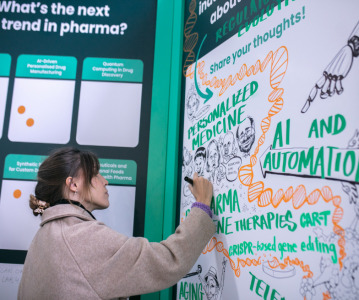Which 10 drugs are open to price negotiation with Medicare in the USA?

The Centres for Medicare & Medicaid Services, under the Biden administration in the USA, has released a list of the 10 drugs that will be open to price negotiations as part of the new legislation under the Inflation Reduction Act (IRA).
The IRA, which President Joe Biden signed in 2022, included a motion to allow Medicare, the federal health insurance provider, to negotiate prices for 10 prescription medications in the USA.
The aim of the negotiations is to decrease the price of prescription drugs for those living in America, who on average pay two or three times more for these drugs than people in other countries.
The 10 medications
1. Eliquis – containing the active substance apixaban, from Bristol-Myers Squibb and Pfizer EEIG, is primarily used to prevent venous thromboembolism occurring in adults who have undergone a hip or knee replacement. It can also be used to treat deep vein thrombosis and pulmonary embolism, and prevent stroke and blot clots elsewhere. It’s most commonly used in patients with multiple risk factors for such conditions or who are 75 years and older.
2. Jardiance – a SGLT2 inhibitor that is used to reduce the risk of cardiovascular death or hospitalisation for heart failure for adults with heart failure, and to reduce the risk of cardiovascular death in adults with Type 2 diabetes mellitus and established cardiovascular disease. Made by Boehringer Ingelheim.
3. Xarelto – otherwise known as rivaroxaban, a brand from Johnson & Johnson, is an anticoagulant medication that is used to treat a range of blood clotting conditions such as stroke, thromboembolism and pulmonary embolisms as well as reducing the risk of major cardiovascular events in patients with coronary artery disease.
4. Januvia – a dipeptidyl peptidase-4 (DPP-4) inhibitor from Merck to be used alongside changes to diet and exercise to improve glycemic control in adults with Type 2 diabetes mellitus. Importantly, it should not be used in patients with Type 1 diabetes or diabetic ketoacidosis.
5. Farxiga – another diabetes treatment, this time from AstraZeneca, specifically for patients with Type 2 diabetes mellitus as a diet supplement, and for patients with heart failure to reduce the risk of cardiovascular death. It must not be used in patients with Type 1 diabetes mellitus or diabetic ketoacidosis.
6. Entresto – made up of sacubitril and valsartan from producer Novartis, is indicated for reducing the risk of cardiovascular death and hospitalisation for heart failure in adult patients with chronic heart failure. The benefits of the medication can be most clearly seen in patients with left ventricular ejection fraction of below normal.
7. Enbrel – the first on the list as a tumour necrosis factor (TNF) blocker from Pfizer. It is used to treat rheumatoid arthritis, polyarticular Juvenile Idiopathic Arthritis (JIA) in patients aged 2 years or older, psoriatic arthritis, Ankylosing Spondylitis (AS), and plaque psoriasis. The label comes with a warning of serious infections and malignancies.
8. Imbruvica – from AbbVie and Janssen Biotech comes the first oncology therapy on the list, the kinase inhibitor Imbruvica. The intended treatment groups includes those with mantle cell lymphoma (MCL) who have received at least one prior therapy, adult patients with chronic lymphocytic leukemia (CLL)/Small lymphocytic lymphoma, adult patients with chronic lymphocytic leukemia (CLL)/Small lymphocytic lymphoma (SLL) with 17p deletion, adult patients with Waldenström’s macroglobulinemia (WM), adult patients with marginal zone lymphoma (MZL) who require systemic therapy and have received at least one prior anti-CD20-based therapy, and adult and paediatric patients aged 1 year and older with chronic graft versus host disease after the failure of one or more prior lines of therapy.
9. Stelara – from Janssen Biotech, is a human interleukin-12 and -23 antagonist. It is used in patients with plaque psoriasis, active psoriatic arthritis, and moderate to severe Crohn’s disease who had previously failed treatment with immunomodulators or corticosteroids, or had failed treatment with one or more TNF blockers.
10. Insulin Aspart – known as NovoLog® from NovoNordisk, is the final diabetes treatment on the list. It is an insulin analog, administered via a pump or intravenously, indicated to improve glycaemic control in adults and children with diabetes mellitus (type 1 and 2).
The drugs chosen clearly reflect the intention of the price negotiation, focusing heavily on medications for chronic diseases, that should lighten the burden of cost from patients with those conditions. Just diabetes treatments in 2015–2017 in the USA were estimated to cost $57.6 billion per year.
The new prices for the drugs will come into force in 2026 and the scheme is predicted to save $25 billion per year on drug prices by 2031.
Some of the pharmaceutical companies involved in the negotiations have expressed concerns over the impact on innovation the negotiations could have, but the knock on effects will remain to be seen.
Sources:
Reuters. Blood thinners, diabetes meds among first 10 drugs for US price negotiations. [Date accessed 04/09/2023]
Taylor SI. The High Cost of Diabetes Drugs: Disparate Impact on the Most Vulnerable Patients. Diabetes Care. 2330–2332, 43(10), (2020).



Related News
-
News US FDA adds haemodialysis bloodlines to devices shortage list
On March 14, 2025, the US FDA published an open letter to healthcare providers citing continuing supply disruptions of haemodialysis bloodlines, an essential component of dialysis machines. -
News Vertex Pharmaceuticals stock jumps as FDA approves non-opioid painkiller
UK-based Vertex Pharmaceuticals saw their stock shares soar as the US FDA signed off on the non-opioid painkiller Journavx, also known as suzetrigine, for patients with moderate to severe acute pain, caused by surgery, accidents, or injuries. -
News Lessons from CPHI Milan 2024: Sunny Intervals for Pharma Manufacturing?
As the 2024 CPHI conference wrapped up in Milan, we caught up with L.E.K. Consulting – a global strategy consulting firm with deep expertise in pharma manufacturing – to discuss evolving market perspectives and business outlook. -
News US BIOSECURE Act passed by US House of Representatives
The controversial act, which has already impacted several foreign companies operating in the US, was passed by the House of Representatives on September 9, 2024. It is now headed for the US Senate before it can be signed into law by President Joe Biden... -
News Pharma Supply Chain People Moves
The latest appointments, promotions, and structural changes across the pharmaceutical supply chain. -
News Drug prices agreed upon as part of the US Inflation Reduction Act
The Inflation Reduction Act brought into constitution by the Biden administation in 2022, which proposed a drug price negotiation between the government and pharmaceutical companies, has reached it's first agreement. -
News BIOSECURE Act continues to loom over Chinese pharma manufacturers
With the US BIOSECURE Act on its way to passing into legislation, Chinese companies are facing declining revenues within the first half of 2024 as US pharmaceutical and healthcare companies pull their businesses from the country. -
News Ophthalmologic drug product Eylea faces biosimilar threats after FDA approvals
Regeneron Pharmaceutical’s blockbuster ophthalmology drug Eylea is facing biosimilar competition as the US FDA approves Biocon’s Yesafili and Samsung Bioepis/Biogen’s Opuviz.
Position your company at the heart of the global Pharma industry with a CPHI Online membership
-
Your products and solutions visible to thousands of visitors within the largest Pharma marketplace
-
Generate high-quality, engaged leads for your business, all year round
-
Promote your business as the industry’s thought-leader by hosting your reports, brochures and videos within your profile
-
Your company’s profile boosted at all participating CPHI events
-
An easy-to-use platform with a detailed dashboard showing your leads and performance






.png)
.png)